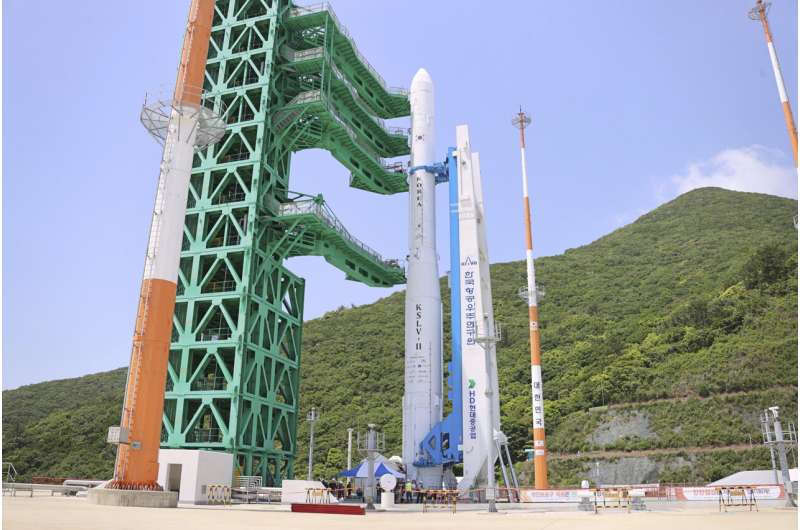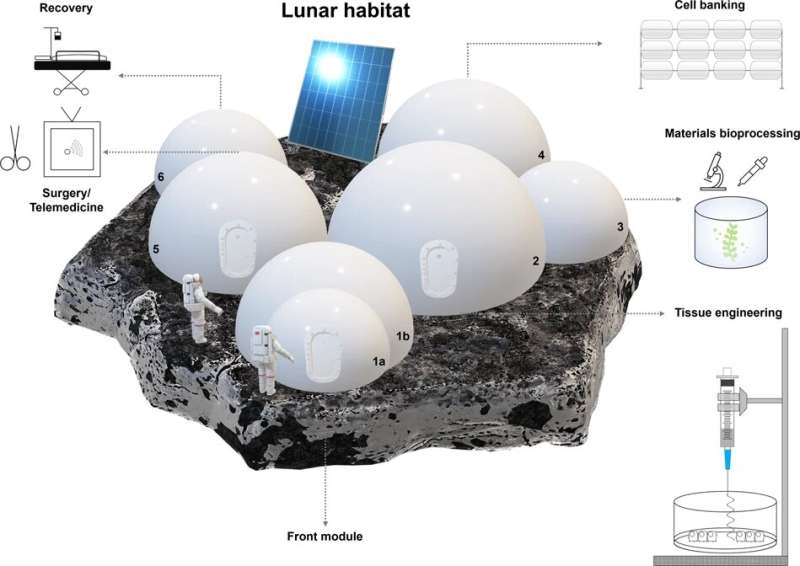
Copernical Team
Wednesday, 24 May 2023 10:02
Global team simulates message from extraterrestrial intelligence to Earth
Mountain View CA (SPX) May 24, 2023
 What would happen if we received a message from an extraterrestrial civilization? Daniela de Paulis, an established interdisciplinary artist and licensed radio operator who currently serves as Artist in Residence at the SETI Institute and the Green Bank Observatory, has brought together a team of international experts, including SETI researchers, space scientists, and artists, to stage her lates
What would happen if we received a message from an extraterrestrial civilization? Daniela de Paulis, an established interdisciplinary artist and licensed radio operator who currently serves as Artist in Residence at the SETI Institute and the Green Bank Observatory, has brought together a team of international experts, including SETI researchers, space scientists, and artists, to stage her lates
 What would happen if we received a message from an extraterrestrial civilization? Daniela de Paulis, an established interdisciplinary artist and licensed radio operator who currently serves as Artist in Residence at the SETI Institute and the Green Bank Observatory, has brought together a team of international experts, including SETI researchers, space scientists, and artists, to stage her lates
What would happen if we received a message from an extraterrestrial civilization? Daniela de Paulis, an established interdisciplinary artist and licensed radio operator who currently serves as Artist in Residence at the SETI Institute and the Green Bank Observatory, has brought together a team of international experts, including SETI researchers, space scientists, and artists, to stage her lates
Published in
News
Tagged under
Wednesday, 24 May 2023 10:02
Rocket Lab scoops up Virgin Orbit Long Beach California assets
Los Angeles CA (SPX) May 24, 2023
 Rocket Lab USA, Inc. has been selected as a successful bidder and is finalizing an asset purchase agreement for the purchase of certain Long Beach California aerospace production and manufacturing assets from Virgin Orbit Holdings, Inc. and certain of its subsidiaries ("Virgin Orbit") in Virgin Orbit's Chapter 11 bankruptcy auction.
Rocket Lab's successful bid of approximately $16.1 millio
Rocket Lab USA, Inc. has been selected as a successful bidder and is finalizing an asset purchase agreement for the purchase of certain Long Beach California aerospace production and manufacturing assets from Virgin Orbit Holdings, Inc. and certain of its subsidiaries ("Virgin Orbit") in Virgin Orbit's Chapter 11 bankruptcy auction.
Rocket Lab's successful bid of approximately $16.1 millio
 Rocket Lab USA, Inc. has been selected as a successful bidder and is finalizing an asset purchase agreement for the purchase of certain Long Beach California aerospace production and manufacturing assets from Virgin Orbit Holdings, Inc. and certain of its subsidiaries ("Virgin Orbit") in Virgin Orbit's Chapter 11 bankruptcy auction.
Rocket Lab's successful bid of approximately $16.1 millio
Rocket Lab USA, Inc. has been selected as a successful bidder and is finalizing an asset purchase agreement for the purchase of certain Long Beach California aerospace production and manufacturing assets from Virgin Orbit Holdings, Inc. and certain of its subsidiaries ("Virgin Orbit") in Virgin Orbit's Chapter 11 bankruptcy auction.
Rocket Lab's successful bid of approximately $16.1 millio
Published in
News
Tagged under
Wednesday, 24 May 2023 10:02
Shenzhou XVI mission to launch in days
Beijing (XNA) May 24, 2023
 China's next manned mission, the Shenzhou XVI, is scheduled to be launched in the coming days to transport three astronauts to the Tiangong space station, according to the China Manned Space Agency.
The Shenzhou XVI crewed spacecraft and its carrier, a Long March 2F rocket, were moved to the service tower on Monday at the Jiuquan Satellite Launch Center in northwestern China's Gobi Desert,
China's next manned mission, the Shenzhou XVI, is scheduled to be launched in the coming days to transport three astronauts to the Tiangong space station, according to the China Manned Space Agency.
The Shenzhou XVI crewed spacecraft and its carrier, a Long March 2F rocket, were moved to the service tower on Monday at the Jiuquan Satellite Launch Center in northwestern China's Gobi Desert,
 China's next manned mission, the Shenzhou XVI, is scheduled to be launched in the coming days to transport three astronauts to the Tiangong space station, according to the China Manned Space Agency.
The Shenzhou XVI crewed spacecraft and its carrier, a Long March 2F rocket, were moved to the service tower on Monday at the Jiuquan Satellite Launch Center in northwestern China's Gobi Desert,
China's next manned mission, the Shenzhou XVI, is scheduled to be launched in the coming days to transport three astronauts to the Tiangong space station, according to the China Manned Space Agency.
The Shenzhou XVI crewed spacecraft and its carrier, a Long March 2F rocket, were moved to the service tower on Monday at the Jiuquan Satellite Launch Center in northwestern China's Gobi Desert,
Published in
News
Tagged under
Wednesday, 24 May 2023 10:02
South Korea postpones third launch of homegrown rocket
Seoul (AFP) May 24, 2023
 South Korea on Wednesday postponed the launch of its homegrown Nuri rocket after a technical glitch was detected just hours before lift-off, officials said.
It was the third planned launch of Nuri, following a failed first attempt and a successful second mission last year.
A communication error between the launch control computer and another computer managing the launch pad was detected
South Korea on Wednesday postponed the launch of its homegrown Nuri rocket after a technical glitch was detected just hours before lift-off, officials said.
It was the third planned launch of Nuri, following a failed first attempt and a successful second mission last year.
A communication error between the launch control computer and another computer managing the launch pad was detected
 South Korea on Wednesday postponed the launch of its homegrown Nuri rocket after a technical glitch was detected just hours before lift-off, officials said.
It was the third planned launch of Nuri, following a failed first attempt and a successful second mission last year.
A communication error between the launch control computer and another computer managing the launch pad was detected
South Korea on Wednesday postponed the launch of its homegrown Nuri rocket after a technical glitch was detected just hours before lift-off, officials said.
It was the third planned launch of Nuri, following a failed first attempt and a successful second mission last year.
A communication error between the launch control computer and another computer managing the launch pad was detected
Published in
News
Tagged under
Wednesday, 24 May 2023 06:25
South Korea to conduct satellite launch as North Korea pushes to fire its 1st military spy satellite

South Korea was set to launch its first commercial-grade satellite Wednesday as rival North Korea pushed plans forward to place its first military spy satellite into orbit.
Published in
News
Tagged under
Wednesday, 24 May 2023 06:45
Satellites provide crucial insights into Arctic amplification

The Arctic, once again at the forefront of climate change, is experiencing disproportionately higher temperature increases compared to the rest of the planet, triggering a series of cascading effects known as Arctic amplification. As concerns continue to grow, satellites developed by ESA have become indispensable tools in understanding and addressing the complex dynamics at play and the far-reaching consequences for the environment and human societies.
Published in
News
Tagged under
Tuesday, 23 May 2023 14:04
A lab deep underground could hold the key to habitability on Mars

Published in
News
Tagged under
Tuesday, 23 May 2023 08:46
Northrop Grumman ships IBCS to Poland for WISLA Air Defense system
Huntsville AL (SPX) May 18, 2023
 Northrop Grumman Corporation (NYSE: NOC) has delivered key Integrated Battle Command System (IBCS) components for Poland's WISLA medium range air defense program. With this delivery, IBCS moves closer to being fully fielded as part of Poland's advanced air and missile defense program.
The recent delivery of the IBCS Integrated Fire Control Network (IFCN) relays supports the WISLA program's
Northrop Grumman Corporation (NYSE: NOC) has delivered key Integrated Battle Command System (IBCS) components for Poland's WISLA medium range air defense program. With this delivery, IBCS moves closer to being fully fielded as part of Poland's advanced air and missile defense program.
The recent delivery of the IBCS Integrated Fire Control Network (IFCN) relays supports the WISLA program's
 Northrop Grumman Corporation (NYSE: NOC) has delivered key Integrated Battle Command System (IBCS) components for Poland's WISLA medium range air defense program. With this delivery, IBCS moves closer to being fully fielded as part of Poland's advanced air and missile defense program.
The recent delivery of the IBCS Integrated Fire Control Network (IFCN) relays supports the WISLA program's
Northrop Grumman Corporation (NYSE: NOC) has delivered key Integrated Battle Command System (IBCS) components for Poland's WISLA medium range air defense program. With this delivery, IBCS moves closer to being fully fielded as part of Poland's advanced air and missile defense program.
The recent delivery of the IBCS Integrated Fire Control Network (IFCN) relays supports the WISLA program's
Published in
News
Tagged under
Tuesday, 23 May 2023 08:46
AFRL conducts Swarm technology demonstration
Kirtland AFB NM (SPX) May 17, 2023
 The Air Force Research Laboratory, or AFRL, conducted a demonstration, April 5, 2023, of its high-power microwave counter drone weapon, the Tactical High-power Operational Responder, or THOR, as it engaged a swarm of multiple targets at the Chestnut Test Site, Kirtland Air Force Base.
"The THOR team flew numerous drones at the THOR system to simulate a real-world swarm attack," said Adrian
The Air Force Research Laboratory, or AFRL, conducted a demonstration, April 5, 2023, of its high-power microwave counter drone weapon, the Tactical High-power Operational Responder, or THOR, as it engaged a swarm of multiple targets at the Chestnut Test Site, Kirtland Air Force Base.
"The THOR team flew numerous drones at the THOR system to simulate a real-world swarm attack," said Adrian
 The Air Force Research Laboratory, or AFRL, conducted a demonstration, April 5, 2023, of its high-power microwave counter drone weapon, the Tactical High-power Operational Responder, or THOR, as it engaged a swarm of multiple targets at the Chestnut Test Site, Kirtland Air Force Base.
"The THOR team flew numerous drones at the THOR system to simulate a real-world swarm attack," said Adrian
The Air Force Research Laboratory, or AFRL, conducted a demonstration, April 5, 2023, of its high-power microwave counter drone weapon, the Tactical High-power Operational Responder, or THOR, as it engaged a swarm of multiple targets at the Chestnut Test Site, Kirtland Air Force Base.
"The THOR team flew numerous drones at the THOR system to simulate a real-world swarm attack," said Adrian
Published in
News
Tagged under
Tuesday, 23 May 2023 08:46
A new tool for deforestation detection
Beijing, China (SPX) May 19, 2023
 Every second, the planet loses a stretch of forest equivalent to a football field due to
logging, fires, insect infestation, disease, wind, drought, and other factors. In a recently published study, researchers from the U.S. Geological Survey Earth Resources Observation and Science (EROS) Center presented a comprehensive strategy to detect when and where forest disturbance happens at a lar
Every second, the planet loses a stretch of forest equivalent to a football field due to
logging, fires, insect infestation, disease, wind, drought, and other factors. In a recently published study, researchers from the U.S. Geological Survey Earth Resources Observation and Science (EROS) Center presented a comprehensive strategy to detect when and where forest disturbance happens at a lar
 Every second, the planet loses a stretch of forest equivalent to a football field due to
logging, fires, insect infestation, disease, wind, drought, and other factors. In a recently published study, researchers from the U.S. Geological Survey Earth Resources Observation and Science (EROS) Center presented a comprehensive strategy to detect when and where forest disturbance happens at a lar
Every second, the planet loses a stretch of forest equivalent to a football field due to
logging, fires, insect infestation, disease, wind, drought, and other factors. In a recently published study, researchers from the U.S. Geological Survey Earth Resources Observation and Science (EROS) Center presented a comprehensive strategy to detect when and where forest disturbance happens at a lar
Published in
News
Tagged under

